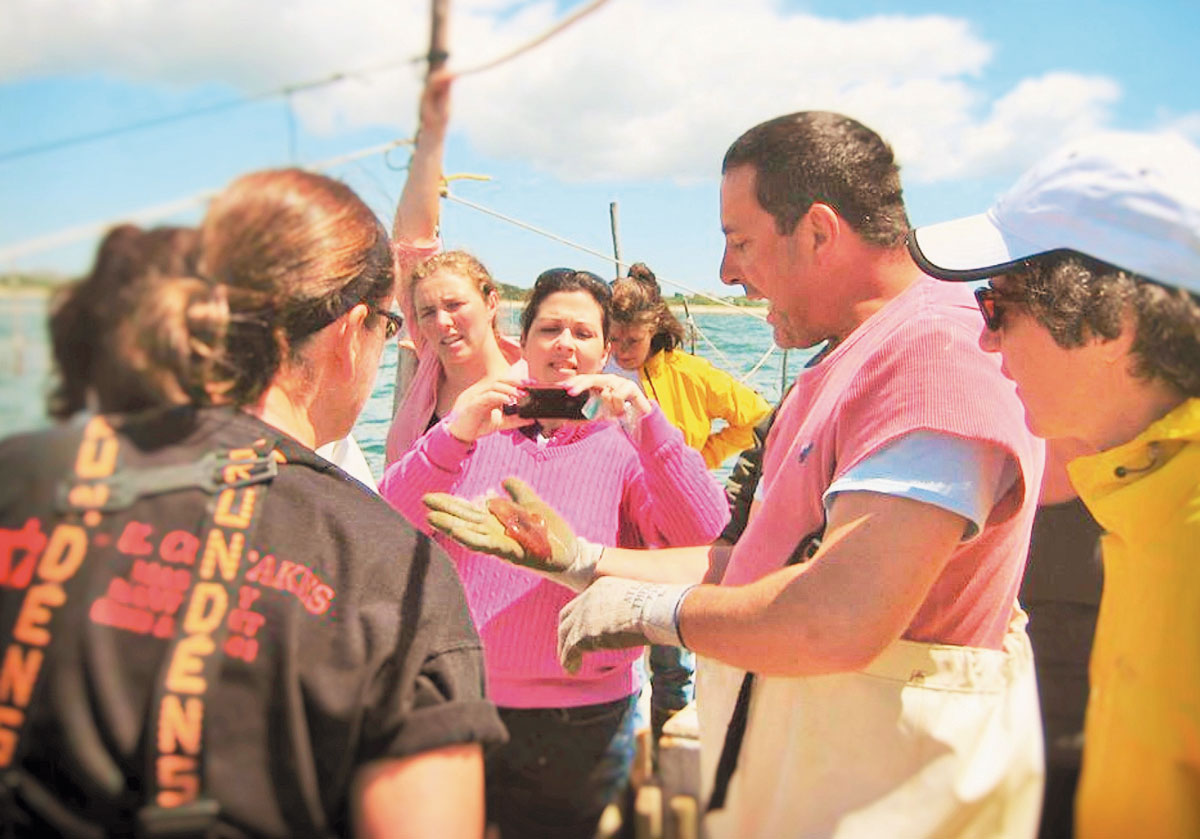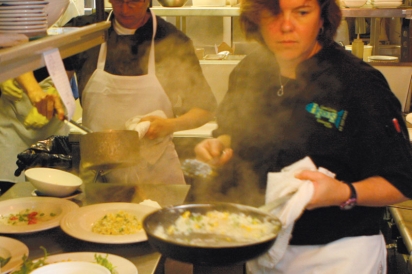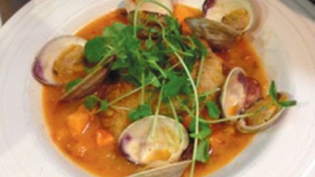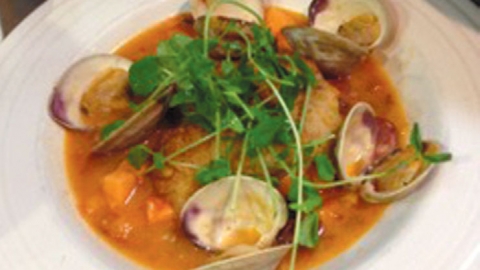Fishing for Real Food
Not every morning on the docks, or on the weirs, is routine. In fact, some days there are things that happen that change your whole life. One early morning in April, I arrived at the docks to find about twenty people waiting. I was still partially asleep as I walked by them and went into the building to find my boots.
“Who are all these people?” I asked Ernie. “It’s the staff from Pisces restaurant,” he said. “They’re going to feature Chatham weir-caught fish on the menu, so the owners wanted the staff to see where the fish comes from.” I took a deep breath, and headed back out to greet our guests.
Whenever we take people out on the weirs, I basically do most of the talking. I tell them about the ancient fishing method of the weirs, I talk about how ecologically friendly our style of fishing is, and all the different fishes that come into our nets. I have a lot of fun with it, really. Anyone who comes fishing with us always loves it. We are a friendly bunch, and love what we do. We love sharing it with those who have enough curiosity to venture out on the high seas with us. Today was a bit different, though. These people will be buying and preparing our fish to feature on their menu.
The owners of the Chatham restaurant Pisces, Sue Connors and Ann Feeley, introduced themselves and then presented all the waiters, bartenders, prep cooks—the whole restaurant staff has come to see how we fish. Right away, I felt pretty good about this. In my mind, this is how our food system should work. I catch the fish. You have a restaurant in town, so you come and buy it fresh off the boat. Both parties get a good price, which is a win-win. And customers get a fresh, local, seasonal product. It’s a dream come true!
The Pisces crew looked filled with anticipation as we motored out of the harbor. I felt wide awake now, talking about the history of our weir company, some fun stories about big days with big fish, and all about the incredibly beautiful waters off the coast of Cape Cod. As I talked about our life on the sea to our new restaurant friends, I felt excitement about the connection we were making. It’s almost a mystery as to why this hadn’t happened before.
You know what is an equally baffling mystery? Why more restaurants don’t feature truly locally caught fish. Wouldn’t that be fairly easy to facilitate? I realize that customers expect certain things to be on a menu, such as cod, shrimp, and salmon, but many of these fish are not caught locally. I have amazing memories from the ‘70s, eating delicious mackerel and bluefish, bass and tautog. We had it made in those days. All the fish we ate came right from our own waters. It was fresh, and wild caught.
I asked Connors what she saw happening in food trends over the years. “Somewhere along the way, something changed in the food business. Everything seems to be shipped from afar. We’ve lost touch with the local land and waters for a while,” said Connors. She continued, “I grew up in a family that had a farm share. Some of my relatives were fishermen, and many were avid gardeners. Each season we reaped the seasonal bounty. We came to the Cape summers, and dug clams and quahogs. We fished for scup and flounder and bass. It was just naturally a way of life, and a way of eating. We really enjoyed all the foods that were all around us.
“There was a whole period, where transportation became efficient enough to ship food from across the globe, so restaurants, grocery stores...they all just bought whatever was available on this global market. Suddenly, you could get fresh strawberries in January. It seemed almost magical, but I think this lured people away from exploring locally-produced foods for a while.”
I thought about it and then added “And you don’t even know how these imported foods are made! If they were sprayed with chemicals, or harvested with slave labor!”
A lion’s share of our incredible fresh fish is shipped off Cape immediately, bound for foreign markets, bound for other places. The reason is because people here on the Cape don’t want much of it. Many restaurants reap better profits from frozen shrimp from Thailand, farm-raised frozen tilapia, farm-raised salmon, and cod shipped from Iceland. Almost 90% of our seafood is imported from foreign fisheries, and yet we have beautiful fresh fish right here in local waters. Just a few, discerning chefs have the desire to put new, cutting edge dishes with our locally, wild caught, fresh fish on the menu.
“As a chef,” Connors said, “I felt the need to return to a more local approach to food. There was a time when it was more fashionable to serve imported, unusual items, but for me, I wanted to get back to the foods we have all around us. It just made sense, and was always a core part of my relationship with food as well.”
Later, dropping by Pisces turned into a great event. One afternoon I swung by to see if Connors needed any fish for the weekend. She was behind the line, sautéing squid in a pan. “You want to try some?” she asked. I certainly did. I was hungry after a day on the water and the aromas in the kitchen were incredible. She handed me a small plate. After one bite, I realized she was a masterful chef. The flavors exploded in my mouth...slightly smoky, very lightly seasoned, flash seared...utter perfection!
“This is the best squid I’ve ever had!” I blurted out. “How do you get this subtle smoky flavor?” We talked about food preparation, not over-seasoning. One should always taste the flavor of the seafood, and the sauce or spicing should only highlight the freshness of the fish.
I was curious to understand how a chef takes, say, a filet of bonito, and creates a new special. Connors replied, “I always have ideas rolling around. I start by trying the preparations a few different ways. Ann and I will try them, and talk about what’s working. Eventually, you come to a dish that tastes exactly how you imagined, and you know it’s ready to go on the menu.”
Connors made a dish with locally caught hake that haunts me to this day. It was delicately crisp on the outside and tender and moist on the inside, with a seasoning so subtle you just wanted another bite so you could experience it again and again. That hake was magical, and I think about it often. It doesn’t happen too often that I reminisce about a piece of fish I have eaten.
I asked Connors about locally sourced foods, and how she finds her purveyors. “Sometimes it’s word of mouth, sometimes someone will swing by the restaurant with some produce for us to try, and sometimes I seek someone out. I found the weir fish by asking around town. I had heard of the weirs, but I didn’t know how to get in touch with Ernie Eldredge. When I finally did connect with him, we both had some concerns. He was concerned that he couldn’t guarantee fish every day, or what kind, and I was concerned that I couldn’t guarantee an amount that I’d want to buy consistently. We tried it out, and it’s worked very well. We talk on the phone and make plans for the week as best we can.
“I get these amazing heirloom tomatoes from a backyard grower, but only for a few weeks each year. When they’re in season, I put them on the menu. This way, there are always new and seasonal items offered, and people can enjoy them. You have to be flexible as a chef. For me, new items are what keep me on my game. People bring me new things, and I have to create dishes. That’s what makes being a chef fun, and exciting.”
My relationship with Pisces is a wonderful balance of practicality, art, and passion for local food. Connors has tried just about every kind of fish we catch in her restaurant. The staff is excited about these creations because they went fishing with us and saw the tradition we participate in by fishing the weirs on Nantucket Sound. Everyone is involved, and cares. Now, instead of just serving or eating food, we are sharing food together; sharing the harvesting and the preparation. We’ve become good friends in a small Cape Cod town. The whole circle has been completed. It’s a very satisfying way to experience our local abundance.
For a Pisces receipe featuring local hake and littlenecks, click here.








